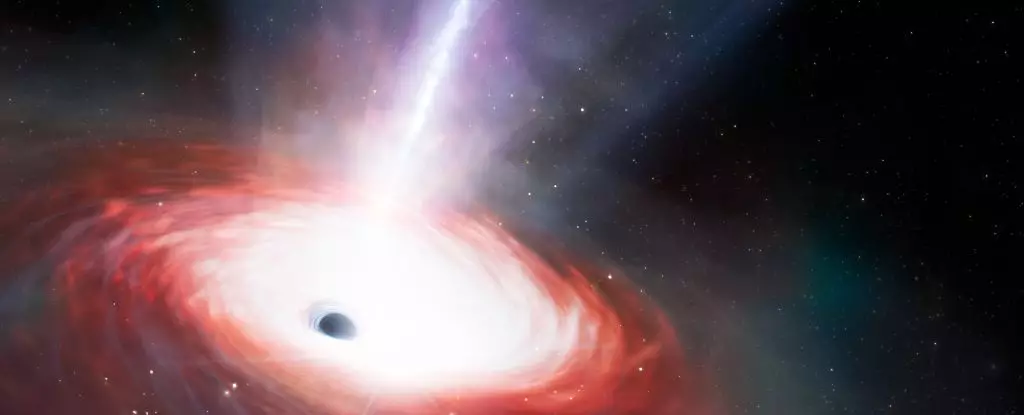In a striking discovery that deepens our understanding of the Universe’s formative years, astronomers have identified an exceptionally luminous supermassive black hole situated in the early stages of cosmic history. Found within the galaxy LID-568, this black hole is consuming material at an astonishing rate—over 40 times what is considered the maximum threshold known as the Eddington limit. This finding not only excites astronomers but also provides critical evidence to investigate how supermassive black holes grew to such enormous scales in a relatively brief period following the Big Bang.
The research, led by a team from the Gemini Observatory and the National Science Foundation’s NOIRLab, highlights a unique mechanism of fast feeding that may explain the rapid accumulation of mass in these astronomical giants. Julia Scharwächter, one of the leading astronomers involved, emphasizes this black hole’s extraordinary appetite, which embodies a key piece in the puzzle of early cosmic evolution.
To comprehend the significance of this supermassive black hole and its feeding frenzy, one must understand the concept of the Eddington limit. Essentially, this theoretical boundary represents the equilibrium between gravitational pull and radiative pressure. When matter spirals toward a black hole, it forms an accretion disk characterized by intense heat and radiation due to friction and gravitational forces. As energy emanates from this disk, photons exert outward pressure, counteracting the inward gravitation of the black hole. This balance defines the maximum possible accretion rate that a black hole can achieve without losing material to radiation forces.
Yet, the discovery of LID-568 presents a remarkable deviation from this established norm. The notion of super-Eddington accretion allows for a scenario where these cosmic giants can exceed their maximum feeding limits, effectively consuming material at an unprecedented scale. This phenomenon could explain how such incredibly massive black holes emerged early in the Universe’s history, defying expectations and challenging current astrophysical models.
Methodology: A Technological Triumph
Led by astronomer Hyewon Suh, this groundbreaking study employed the powerful capabilities of the James Webb Space Telescope (JWST) to gain insights into the galaxy LID-568. While previous observations from the Chandra X-ray Observatory indicated X-ray brightness, the galaxy itself was difficult to pinpoint due to its faintness. The team utilized JWST’s advanced NIRSpec integral field spectrograph, allowing them to hone in on LID-568’s precise location across the cosmic expanse.
The results were astonishing: despite LID-568’s faint appearance to the naked eye, its intrinsic brightness suggests that it resides at a remarkable distance, underlining the potential energy present within its accretion processes. Detailed spectral analysis revealed powerful outflow jets emanating from the supermassive black hole, indicative of extreme feeding modes where material gets ejected even as the black hole voraciously consumes mass.
Upon closer examination, the supermassive black hole at the center of LID-568 was found to be relatively small compared to its monstrous counterparts, possessing a mass equivalent to 7.2 million times that of our Sun. However, the exceptional photonic output from its accretion disk was significantly higher than would typically be expected from a black hole of its size. The analysis suggested that this black hole operates at a staggering accretion rate far exceeding the Eddington limit, hinting at an ephemeral burst of super-Eddington feeding that was fortuitously captured by the observatory.
Such findings raise intriguing questions surrounding the very formation mechanisms of supermassive black holes. Current hypotheses posit that instead of forming from collapsing stars, the first generation of supermassive black holes may have emerged from massive primordial stars or concentrated gas clouds collapsing directly under gravitational forces. This model suggests a distinct path to colossal size, thus paving the way for a more profound comprehension of cosmic evolution and the early Universe’s structure.
The Road Ahead: Implications for Astrophysics
As research into LID-568 progresses, the potential implications for our understanding of the Universe is profound. This discovery opens doors for continued observations that could yield insights into super-Eddington processes and the early growth patterns of supermassive black holes. The astronomical community eagerly anticipates the opportunity to observe LID-568 and similar celestial objects, as each insight gained helps illuminate the dark corners of our Universe’s history.
The rapid feeding of supermassive black holes like LID-568 not only fascinates astronomers but also serves as a pivotal component in unraveling one of the most significant mysteries about the early Universe. With further exploration and analysis, we may well be on the verge of transforming our grasp of cosmic genesis and development, specifically how these galactic giants emerged amidst the grand tapestry of cosmic history.


Leave a Reply